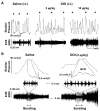Delivery of the 5-HT2A Receptor Agonist, DOI, Enhances Activity of the Sphincter Muscle during the Micturition Reflex in Rats after Spinal Cord Injury
- PMID: 33477834
- PMCID: PMC7832846
- DOI: 10.3390/biology10010068
Delivery of the 5-HT2A Receptor Agonist, DOI, Enhances Activity of the Sphincter Muscle during the Micturition Reflex in Rats after Spinal Cord Injury
Abstract
Traumatic spinal cord injury (SCI) interrupts spinobulbospinal micturition reflex pathways and results in urinary dysfunction. Over time, an involuntary bladder reflex is established due to the reorganization of spinal circuitry. Previous studies show that manipulation of serotonin 2A (5-HT2A) receptors affects recovered bladder function, but it remains unclear if this receptor regulates the activity of the external urethral sphincter (EUS) following SCI. To elucidate how central and peripheral serotonergic machinery acts on the lower urinary tract (LUT) system, we employed bladder cystometry and EUS electromyography recordings combined with intravenous or intrathecal pharmacological interventions of 5-HT2A receptors in female SCI rats. Three to four weeks after a T10 spinal transection, systemic and central blockage of 5-HT2A receptors with MDL only slightly influenced the micturition reflex. However, delivery of the 5-HT2A receptor agonist, DOI, increased EUS tonic activity and elicited bursting during voiding. Additionally, subcutaneous administration of DOI verified the enhancement of continence and voiding capability during spontaneous micturition in metabolic cage assays. Although spinal 5HT2A receptors may not be actively involved in the recovered micturition reflex, stimulating this receptor subtype enhances EUS function and the synergistic activity between the detrusor and sphincter to improve the micturition reflex in rats with SCI.
Keywords: electromyogram; external urethral sphincter; micturition; serotonin; spinal cord injury.
Conflict of interest statement
The authors declare no competing interests.
Figures





Similar articles
-
Spinal Dopaminergic Mechanisms Regulating the Micturition Reflex in Male Rats with Complete Spinal Cord Injury.J Neurotrauma. 2021 Mar 15;38(6):803-817. doi: 10.1089/neu.2020.7284. Epub 2021 Jan 21. J Neurotrauma. 2021. PMID: 33297828 Free PMC article.
-
Deciphering Spinal Endogenous Dopaminergic Mechanisms That Modulate Micturition Reflexes in Rats with Spinal Cord Injury.eNeuro. 2021 Jul 29;8(4):ENEURO.0157-21.2021. doi: 10.1523/ENEURO.0157-21.2021. Print 2021 Jul-Aug. eNeuro. 2021. PMID: 34244339 Free PMC article.
-
Improvement of lower urinary tract function by a selective serotonin 5-HT1A receptor agonist, NLX-112, after chronic spinal cord injury.Exp Neurol. 2020 Oct;332:113395. doi: 10.1016/j.expneurol.2020.113395. Epub 2020 Jun 30. Exp Neurol. 2020. PMID: 32615138 Free PMC article.
-
Plasticity in reflex pathways to the lower urinary tract following spinal cord injury.Exp Neurol. 2012 May;235(1):123-32. doi: 10.1016/j.expneurol.2011.05.003. Epub 2011 May 9. Exp Neurol. 2012. PMID: 21596038 Free PMC article. Review.
-
Neurochemical plasticity and the role of neurotrophic factors in bladder reflex pathways after spinal cord injury.Prog Brain Res. 2006;152:97-115. doi: 10.1016/S0079-6123(05)52007-7. Prog Brain Res. 2006. PMID: 16198696 Review.
Cited by
-
Locomotor Exercise Enhances Supraspinal Control of Lower-Urinary-Tract Activity to Improve Micturition Function after Contusive Spinal-Cord Injury.Cells. 2022 Apr 20;11(9):1398. doi: 10.3390/cells11091398. Cells. 2022. PMID: 35563703 Free PMC article.
-
Upregulated 5-HT1A Receptors Regulate Lower Urinary Tract Function in Rats after Complete Spinal Cord Injury.J Neurotrauma. 2023 May;40(9-10):845-861. doi: 10.1089/neu.2022.0329. Epub 2023 Mar 14. J Neurotrauma. 2023. PMID: 36762948 Free PMC article.
References
Grants and funding
LinkOut - more resources
Full Text Sources
Other Literature Sources
Research Materials

